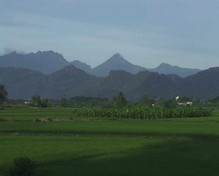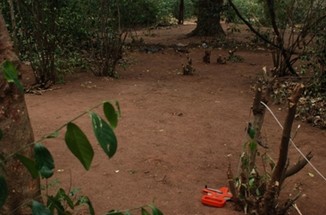Agasthya
A newsletter on the Natural History, Ecology
and Conservation of the Agasthyamalai region, Western Ghats, India.
ASHOKA TRUST FOR RESEARCH IN ECOLOGY AND THE ENVIRONMENT
Centre for Excellence in Conservation Science
Royal Enclave,Srirampura,Jakkur Post
Bangalore-560064
Telephone: 080-23635555 (EPABX)
Fax : 080- 23530070
Any and all opinions expressed in this newsletter are solely those of the author(s) and do not reflect the opinion of ATREE.
Editorial Team
Editor: T. Ganesh
Associate editor: Vivek Ramachandran
Editorial Review: R. Ganesan, M. Soubadra Devy
Design and presentation: Vivek Ramachandran
A S H O K A T R U S T F O R R E S E A R C H I N E C O L O G Y A N D T H E E N V I R O N M E N T
Camping impact on vegetation: a case study
Bidisha Nandy & Sabitha Krishnan
Effect of camping on saplings and shrubs.
Photo- R. Ganesan
Dry evergreen forest habitat in Mundanthurai play an important role to maintain the biodiversity of this area. It is the refuge of several endemic plant species and also serves as a corridor for some pollinators such as butterflies. In spite of less rainfall this forest is still classified as a evergreen forest .Within this dry evergreen forest happens the Sorimuthaian temple festival with its own historical and traditional significance for the local community. But the impact of this festival is severe on vegetation of this fragile habitat. Hence, temple festival is a perfect example of human-nature conflict. Our study aim was to survey and analyze the effect of camping on vegetation and elucidate some probable solutions to prevent the degradation. We used the line transact method to enumerate the vegetation from disturbed area to the undisturbed (regenerated ) forest site in a total area of one hectare.
The results indicate that the dominants species in the disturbed area and the regenerated forest are different. In undisturbed area the tree Miliusa eriocarpa is dominant. In disturbed area the primary species tree Aglaia courtellensis is dominant. The area clearance and canopy cover were on average 80 % and 32 % respectively in highly disturbed area. Sapling damage in disturbed area was more compared to trees. The sapling density increased from disturbed to undisturbed areas. The understorey was cleared (upto 85%) and there were large canopy gaps in the disturbed areas compare to regenerated forest. The area clearance decreased to 51% as moved from the away zones of high disturbance . The maximum canopy cover was 83 % in regenerated forest and the canopy cover decreased to 69% as we moved to more disturbed areas. Light loving plant species like liana and pioneer plant species were the dominants in disturbed areas. We have some suggestions to prevent the degradation of the forest such as limited access to the temple site and arrangement of some temporary shelter for pilgrims.








